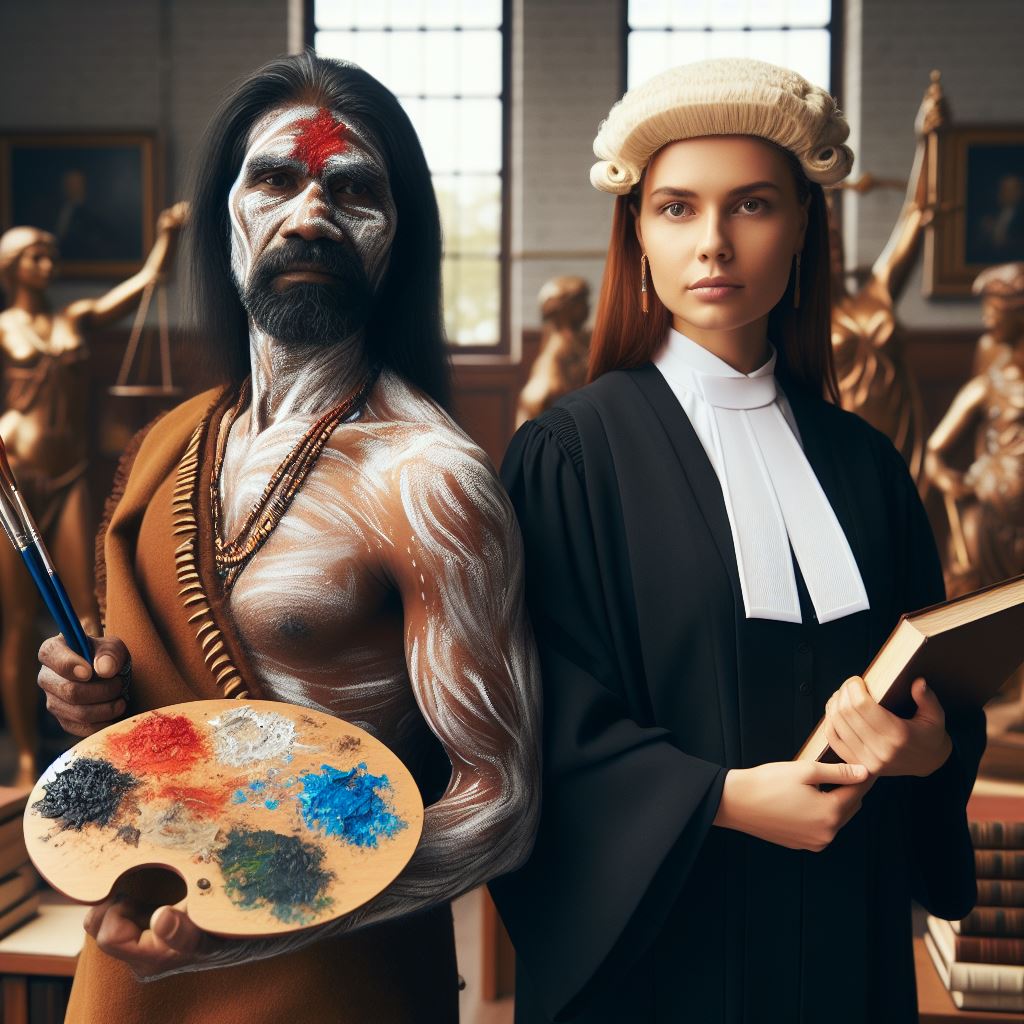Introduction
Commissioned art refers to artworks that are created based on a specific request or commission from a client.
Understanding the legal aspects of commissioned art is crucial to ensure that both artists and clients are protected.
By knowing the legal must-knows, artists can confidently navigate the commission process, while clients can be aware of their rights and obligations.
Commissioned art plays a significant role in the art market, as it allows clients to have personalized artworks that cater to their specific preferences and requirements.
Artists, on the other hand, benefit from commissioned projects as they provide them with opportunities to showcase their talents and skills.
However, when entering into a commissioned art agreement, it is essential to consider the legal aspects associated with it.
Firstly, copyright ownership is a crucial consideration.
While the art is commissioned, the artist still retains the copyright unless specifically assigned to the client.
Furthermore, payment terms and conditions should be clearly outlined in a written agreement to avoid any misunderstandings or disputes later on.
The agreement should also include provisions regarding deadlines, revisions, and any other specifications agreed upon by both parties.
Another legal aspect to consider is the moral rights of artists.
Even if the copyright is transferred, artists have the right to be acknowledged as the creator of the artwork.
In a nutshell, understanding the legal aspects of commissioned art is vital for both artists and clients.
It provides clarity, protection, and ensures a smooth commission process.
By being knowledgeable about copyright, payment terms, moral rights, and other legal must-knows, both parties can engage in commissioning art with confidence and peace of mind.
Copyright Law
Explanation of copyright protection
- Copyright protection grants exclusive rights to the creators of original artistic works.
- It covers various forms such as paintings, sculptures, photographs, and digital artwork.
- The copyright owner has the right to reproduce, distribute, and display their work.
How it applies to commissioned artwork
- Copyright law automatically applies to commissioned artwork as soon as it is created.
- The creator retains the copyright unless an agreement states otherwise.
- Commissioned artwork cannot be used or reproduced without the creator’s permission.
Rights and limitations of the artist and client
- The artist retains the right to be recognized as the creator of the commissioned artwork.
- The client has the right to use the artwork for the agreed-upon purposes.
- The client cannot modify or reproduce the artwork beyond the scope of the agreement.
Importance of written agreements
- Written agreements clarify the rights and responsibilities of both the artist and the client.
- It helps avoid misunderstandings and legal disputes regarding the commissioned artwork.
- Written agreements should specify the permitted uses, duration, and compensation for the artwork.
In the realm of commissioned art in Australia, understanding copyright law is crucial for both artists and clients. Copyright protection grants exclusive rights to creators, covering commissioned artwork as well.
Artists have the right to be recognized as the creators, while clients have the right to use the artwork for agreed-upon purposes. However, the client’s usage is limited by the agreement, and modifications or reproductions require the artist’s permission.
Having written agreements is of utmost importance to avoid conflicts and clarify rights and responsibilities. It is essential to include details such as permitted uses, duration, and compensation.
Being aware of copyright law’s provisions ensures a mutually beneficial relationship between artists and clients in the Australian art industry.
Read: Ghostwriting in Australia: An Insider’s View
Contractual Agreements
Importance of written contracts
- Establishing a written contract is crucial in commissioning art projects in Australia.
- Written contracts provide a clear record of the agreement to avoid misunderstandings.
- They establish legal protection for both the artist and the client involved in the project.
- Written contracts ensure that all terms, expectations, and conditions are documented and agreed upon.
- They serve as evidence in case of any disputes or conflicts that may arise during the project.
- Written contracts protect the artist’s intellectual property rights, including copyright ownership.
Key elements to include in a commission agreement
- The names and contact details of both the artist and the client should be clearly stated.
- The scope of the project, including the specific art form, size, and medium, must be outlined.
- The timeline and deadlines for each stage of the project should be agreed upon and included.
- The price agreed upon for the artwork, including any additional fees or expenses, should be detailed.
- Payment methods and terms, such as installment plans or lump sum payments, should be specified.
- Ownership rights and any potential transfer of copyright should be clearly addressed in the agreement.
- The process for changes and revisions to the artwork should be clearly outlined for both parties.
- Any terms regarding confidentiality, exclusivity, or exhibition of the artwork should be included.
- The agreement should outline the consequences of breach of contract and dispute resolution methods.
- Both parties should sign and date the agreement to indicate their acceptance and understanding of the terms.
Determining the scope, timeline, and price of the project
- The artist and the client must have a thorough discussion to determine the scope of the project.
- Details such as art style, size, complexity, and desired outcomes should be clarified.
- A timeline should be agreed upon to ensure that both parties are aware of project deadlines.
- Factors such as the artist’s availability, required research, and production time should be considered.
- The price of the project should be determined based on factors like the artist’s experience and expertise.
- Both parties should negotiate a fair and reasonable price that accurately reflects the artwork’s value.
- Additional costs, such as materials, shipping, or installation, should also be discussed and agreed upon.
Dealing with changes, revisions, and copyright transfer
- The commission agreement should clearly state how changes and revisions will be handled.
- Artists may charge additional fees if significant changes are requested after a certain stage.
- The agreement should specify whether the artist retains the right to make minor alterations.
- Any transfers of copyright ownership should be clearly detailed in the commission agreement.
- If copyright is being transferred, both parties should sign a separate copyright transfer agreement.
- In the absence of a written agreement, artists typically retain copyright ownership of their work.
- Artists may grant the client a license to use the artwork for specific purposes if desired.
Read: Australia’s Top Literary Magazines in 2024
Intellectual Property Rights
Understanding intellectual property rights
- Intellectual property rights refer to legal rights granted to creators of original works.
- These rights protect the exclusive use and exploitation of creations, such as art and designs.
- Intellectual property rights include copyright, trademarks, patents, and designs.
- In Australia, intellectual property rights are protected under various laws and regulations.
Who owns the rights to the commissioned artwork
- Ownership of the commissioned artwork depends on the agreement between the artist and the client.
- By default, the creator of the artwork retains the intellectual property rights, unless otherwise specified.
- Artists should clearly outline ownership rights in their contracts to avoid future conflicts.
Applicable laws and court cases related to IP rights in Australia
- The Copyright Act 1968 is the primary legislation governing intellectual property rights in Australia.
- This act grants creators exclusive rights to reproduce, publish, and control their artistic works.
- Other relevant laws include the Designs Act 2003 and the Trade Marks Act 1995.
- Court cases like IceTV v. Nine Network and Roadshow Films v. iiNet have shaped IP rights jurisprudence.
Protecting the rights of both the artist and the client
- Artists should clearly define the scope of their rights and limitations in the commissioned artwork contract.
- Clients should respect the intellectual property rights of the artist and seek permission for any commercial use.
- Including a clause regarding moral rights, which protect the reputation and integrity of the artwork, is essential.
- Artists can consider registering their artwork with the Australian Copyright Council or other relevant organizations.
- Clients should also include provisions for licensing and royalties if they intend to use the artwork commercially.
In the world of commissioned art, understanding intellectual property rights is crucial for both artists and clients.
By clearly defining ownership, respecting rights, and including necessary clauses in contracts, both parties can protect their interests.
Being aware of applicable laws and court cases in Australia further ensures a fair and legal environment for commissioned artworks.
Moral Rights
Explanation of moral rights in Australia
- Moral rights are a set of legal rights that protect the personal and artistic integrity of creators.
- These rights are separate from copyright and exist to safeguard the non-economic interests of artists.
- In Australia, moral rights are protected under the Copyright Act 1968.
How it affects commissioned artwork
- When commissioning an artwork, the artist retains their moral rights even if the copyright is transferred.
- These rights include the right to be attributed as the creator and the right to object to derogatory treatment.
- Derogatory treatment refers to any modification or distortion that may harm the artist’s reputation.
Responsibilities of the artist and client regarding moral rights
- Artists have a responsibility to assert their moral rights and ensure they are properly acknowledged for their work.
- Clients must respect the moral rights of the artist and refrain from any derogatory treatment of the commissioned artwork.
- Both parties should include explicit terms concerning moral rights in their commissioning agreement.
Resolving disputes and legal remedies for violations
- If a dispute arises regarding moral rights, it is advisable to try resolving it through negotiation or mediation.
- If these attempts fail, the aggrieved party can seek legal remedies in the form of a court injunction or damages.
- The Copyright Tribunal of Australia may also provide a dispute resolution mechanism for moral rights cases.
Importance of understanding moral rights in commissioned art
- Moral rights are crucial for artists as they protect their reputation and control over their creative works.
- Clients should be aware of their obligations to respect these rights to maintain positive relationships with artists.
- Understanding moral rights promotes ethical and responsible practices in the creation and display of commissioned artwork.
Moral rights in Australia play a significant role in protecting the artistic integrity and reputation of creators.
Artists retain these rights even when they transfer copyright, making it essential for clients to understand their obligations.
Respecting moral rights fosters a fair and equitable relationship between artists and clients, leading to successful commissioning experiences.
Read: Australian Poets: Voices of a Nation

Learn More: Navigating Music Contracts in Australia
Payment and Disputes
In the world of commissioned art, payment is a crucial aspect that both artists and clients need to navigate carefully.
Establishing clear payment terms and methods, ensuring payment security, and resolving disputes are essential steps to ensure a smooth transaction.
Establishing clear payment terms and methods
- Discuss and agree upon the payment terms and conditions before commencing any commissioned work.
- Clearly outline the payment schedule, including due dates and the percentage of payment at each milestone.
- Consider using a written contract or agreement to document the agreed-upon payment terms and protect both parties.
- Specify the acceptable payment methods, such as bank transfer, PayPal, or other secure online payment platforms.
- Communicate any additional fees, such as shipping or handling charges, and include them in the payment agreement.
Ensuring payment security and avoiding scams
- Request a reasonable deposit or upfront payment to mitigate the risk of non-payment or cancellation.
- Research and verify the client’s reputation and credibility before accepting commissioned work.
- Be cautious of potential scams, such as clients asking for personal bank information or offering unusually high payments.
- Consider using escrow services or milestone-based payment systems to ensure secure transactions.
- Stay vigilant and trust your instincts when dealing with unfamiliar clients or suspicious payment requests.
Steps to resolve payment disputes
- Keep detailed records of all communication, agreements, and invoices related to the commissioned work.
- Engage in open and transparent communication with the client to address any payment discrepancies or issues.
- Attempt to negotiate a resolution with the client, such as adjusting the payment terms or offering a compromise.
- If the dispute cannot be resolved informally, consider involving a neutral third party, such as a mediator.
- Explore the option of pursuing legal action as a last resort if all other attempts to resolve the dispute fail.
Seeking legal assistance if necessary
- If the payment dispute escalates and cannot be resolved privately, consult with a legal professional.
- Present all relevant documentation, including the commission agreement and evidence of completed work, to the attorney.
- Seek guidance on potential legal actions available, such as filing a lawsuit or pursuing alternative dispute resolution methods.
- Follow the advice of your legal counsel to effectively navigate the legal process and protect your rights as an artist.
- Remember that legal assistance may incur additional costs, so evaluate the potential outcomes and expenses involved.
By prioritizing clear payment terms, ensuring payment security, and actively addressing any payment disputes that may arise, artists can protect their financial interests and maintain a positive working relationship with their clients.
Read: Children’s Authors in Oz: A Special Niche
Gain More Insights: Podcasting in Australia: Getting Started
Insurance and Liability
Importance of insurance coverage for commissioned artwork
Commissioned artwork holds both artistic and monetary value, making insurance coverage crucial. In case of damage or loss, insurance ensures protection and financial security.
Types of insurances available (e.g., professional liability, artwork insurance)
- Professional Liability Insurance: This type of insurance covers the artist’s liability for mistakes, errors, or negligence in their work.
- Artwork Insurance: Artwork insurance provides coverage for damage, theft, or loss of the commissioned artwork.
Responsibilities of the artist and client in case of damage or loss
Both the artist and client have specific responsibilities when it comes to damage or loss of commissioned artwork.
The artist should ensure proper packaging and safe delivery, while the client should inspect the artwork upon receipt.
Seeking legal advice to understand liability issues
To fully comprehend the complex issues surrounding liability, it is advisable to seek legal advice.
A qualified attorney can provide valuable insights into contractual agreements and potential liabilities.
Your Personalized Career Strategy
Unlock your potential with tailored career consulting. Get clear, actionable steps designed for your success. Start now!
Get StartedInsurance coverage plays a vital role in protecting commissioned artwork. It safeguards against potential damage or loss, ensuring financial security for both the artist and client.
By understanding the available insurance options and seeking legal advice, the artist and client can navigate liability issues effectively.
Conclusion
In this comprehensive exploration of legal facets surrounding commissioned art in Australia, key considerations have surfaced, offering insights crucial for both artists and clients.
It is imperative to recap the significant legal aspects that underpin the commissioning process.
Navigating the intricacies of commissioned art demands a keen awareness of legal nuances.
From intellectual property rights to contractual agreements, our journey highlighted the importance of clarity and transparency in safeguarding the interests of both parties.
Understanding these key legal aspects provides a solid foundation for fostering mutually beneficial collaborations in the realm of commissioned artwork.
While this exploration provides valuable insights, the complexity of legal matters necessitates individualized guidance.
Artists and clients are strongly encouraged to seek professional legal advice tailored to their specific situations.
Consulting with legal experts ensures a nuanced understanding of rights, obligations, and potential pitfalls, fortifying the legal standing of commissioned art arrangements.
Beyond legal considerations, the essence of successful collaborations lies in the cultivation of positive relationships between artists and clients.
Acknowledging and respecting legal obligations fosters an environment of trust and open communication.
By upholding these principles, artists and clients not only ensure the smooth execution of commissioned projects but also lay the groundwork for enduring partnerships built on mutual respect and understanding.
In closing, commissioned art in Australia thrives on a delicate balance between legal acumen and interpersonal dynamics.
As we conclude this exploration, the call to action resonates – be vigilant about legalities, seek professional advice, and, above all, nurture positive relationships.
In doing so, artists and clients can embark on a collaborative journey that not only produces exceptional artwork but also stands as a testament to the harmonious synergy between legal consciousness and creative expression.




